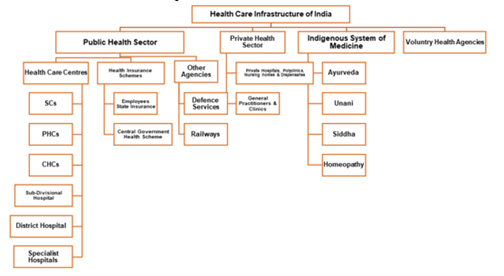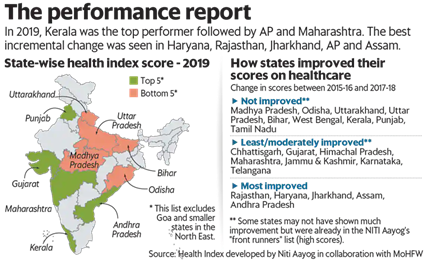Governance
Context: Recently the Government of India and World Bank signed two complimentary loans worth $1 billion to support and enhance India’s healthcare infrastructure.
About India’s healthcare sector at glance:

- In the Economic Survey of 2022, India’s public expenditure on healthcare stood at 1% of GDP in 2021-22 against 1.8% in 2020-21 and 1.3% in 2019-20.
- India had 7 physicians per 1,00,000 people in 2017 (in contrast to 98 in Pakistan, 100 in Sri Lanka and 241 in Japan).
- 53 beds per 1,00,000 people(in contrast to 63 in Pakistan, 79.5 in Bangladesh, 415 in Sri Lanka and 1,298 in Japan).
- 7 nurses and midwives per 1,00,000 people(in contrast to 220 in Sri Lanka, 40 in Bangladesh, 70 in Pakistan, and 1,220 in Japan).
- India has among the highest out-of-pocket (OOP) expenditures of all countries in the world- 62% of the total health expenditure in India is OOP.
- According to the World Health Organization (WHO), India ranks 184 out of 191 countries in health spending.
- The US spends over 16% of its total GDP on healthcare, while Japan, Canada, Germany etc. spend over 10% of their GDP on healthcare.
Health Index for states developed by Niti Aayog:

- The Health Index for States developed by Niti Aayog in consultation with the health ministry and the World Bank has rankings for large states, smaller states and Union territories.
- It is based on 23 health parameters ranging from mortality rate and sex ratio to functioning cardiac care units.
- In 2019, Kerala was the top performer followed by Andhra Pradesh and Maharashtra.
- The index results indicated that states even with a lower economic output are performing better on health and well-being.
Challenges associated with India’s healthcare sector:
- Low Budget Spending: India’s public expenditure on healthcare is only 2.1% of GDP in 2021-22 while Japan, Canada and France spend about 10% of their GDP on public healthcare.
- Unequal distribution: India’s health care system is concentrated in urban areas with very little presence in the rural areas where majority of the population lives.
- Lack of Medical Research: In India, R&D and cutting-edge technology-led new projects receive little attention.
- Low doctor-patient ratio: The doctor patient ratio in India is about 1:1500 much higher than the WHO norm of one doctor for every 1,000 people.
- Lack of Affordability: The contribution of private sector in healthcare expenditure in India is around 80 percent while the rest 20 percent is contributed by Public Sector.
- The private sector also provides for 58 percent of the hospitals and 81 percent of the doctors in India.
Govt of India Initiatives to improve healthcare sector in the country:
- Pradhan Mantri-Ayushman Bharat Health Infrastructure Mission (PM-ABHIM): it aims to strengthen India’s health infrastructure and improve the country’s primary, secondary and tertiary care services.
- Ayushman Bharat : Follows a two- pronged approach by Creation of health and wellness centres to bring health care closer to homes.
- formulation of a Pradhan Mantri Jan Arogya Yojana (PMJAY) to protect poor and vulnerable families against financial risk arising out of health episodes.
- Ayushman Bharat Digital Mission: aims to connect the digital health solutions of hospitals across the country. Under this, every citizen will now get a digital health ID and their health record will be digitally protected.
- National Ayush Mission: it is a centrally sponsored scheme for the development of traditional medicines
- Pradhan Mantri Swasthya Suraksha Yojana (PMSSY):aims to correct regional imbalances in the availability of affordable/reliable tertiary healthcare services and also to augment facilities for quality medical education in the country.
Way Forward:
There is an urgency to focus on all the three levels of primary, secondary and tertiary healthcare, it is imperative that the government look towards improving primary health care as a public good.
The lesson emerging most unequivocally from the pandemic experience is that if India does not want a repeat of the immeasurable suffering and the social and economic loss, we need to make public health a central focus.
There is also a need to declutter policy dialogue and provide clarity to the nomenclatures. India needs to move beyond the doctor-led system and Para medicalise several functions. India should focus on technology upgradation and preventive care to further its march towards healthy India.
Source: The Hindu
Previous Year Questions
Q.1) Consider the following:
- Aarogya Setu
- COWIN
- DigiLocker
- DIKSHA
Which of the above are built on top of open-source digital platforms? (2022)
- 1 and 2 only
- 2, 3 and 4 only
- 1, 3 and 4 only
- 1, 2, 3 and 4
Q.2) With reference to recent developments regarding ‘Recombinant vector Vaccines’, consider the following statements:
- Genetic engineering is applied in the development of these vaccines.
- Bacteria and viruses are used as vectors.
Which of the statements given above is/are correct? (2021)
- 1 only
- 2 only
- Both 1 and 2
- Neither 1 nor 2














